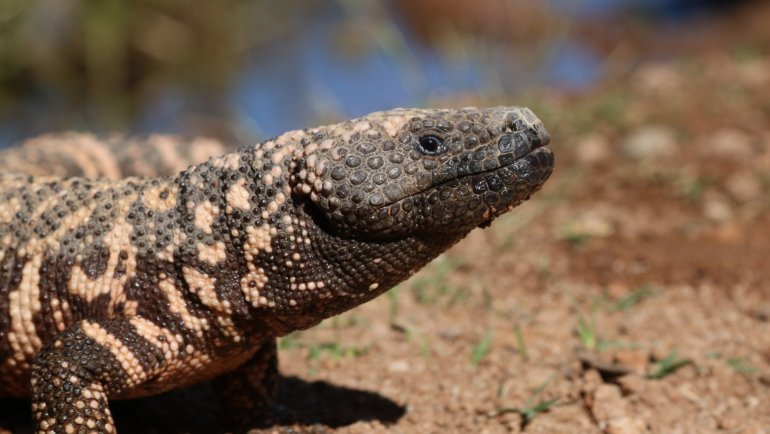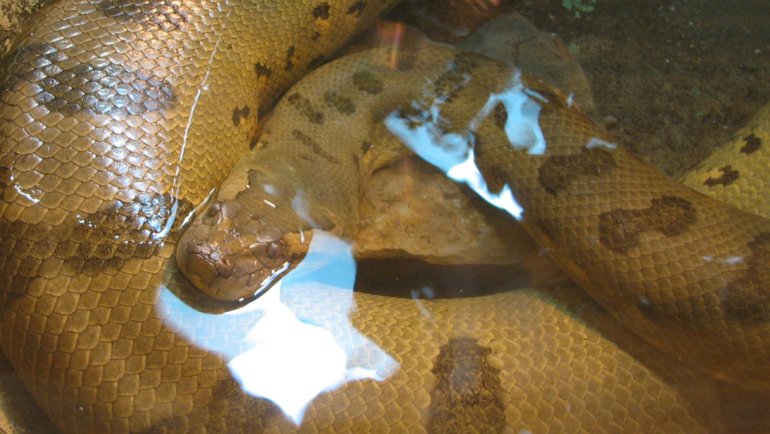Native to the arid landscapes of Australia, the bearded dragon is a unique and captivating reptile, admired for its charismatic expressions and adaptive survival techniques. With spiky “beards” that flare out when threatened and a calm demeanor, these creatures have soared in popularity as exotic pets.
This article delves into the intricacies of the bearded dragon’s life, exploring everything from its native habitat to its captivating behavior and unique characteristics.
The Bearded Dragon at a Glance
Classification
| Kingdom: | Animalia |
| Phylum: | Chordata |
| Class: | Reptilia (Reptiles) |
| Order: | Squamata |
| Family: | Agamidae |
| Genus: | Pogona |
| Species: | Various species such as P. vitticeps |
Essential Information
| Average Size: | 18-24 inches (46-61 cm) |
| Average Weight: | 10-18 oz (280-510 grams) |
| Average Lifespan: | 8-12 years (with proper care, some can live longer) |
| Geographical Range: | Central and Eastern Australia |
| Conservation Status: | Least Concern (IUCN Red List) |
Species and Subspecies
While the term “bearded dragon” commonly refers to the Central bearded dragon (Pogona vitticeps), the genus Pogona encompasses several distinct species. Here’s a glimpse of some species:
- Central Bearded Dragon (Pogona vitticeps): The most well-known species, often kept as a pet. They have a broad distribution in arid regions of Australia and are recognized by their well-defined beard.
- Eastern Bearded Dragon (Pogona barbata): Larger than its Central counterpart, this species has a more pronounced beard and a darker coloration.
- Dwarf Bearded Dragon (Pogona minor): As the name suggests, this species is smaller in size. They inhabit the western and central parts of Australia.
- Western Bearded Dragon (Pogona minima): These dragons have shorter beards and a slightly varied color palette with lighter tones.
- Rankin’s Dragon (Pogona henrylawsoni): Another smaller species, they have less pronounced beards but still hold the iconic look of the genus.
Key differences lie in size, distribution, and, of course, the appearance and prominence of their “beards”. Some species have a darker color palette, while others may be lighter or more vibrant.
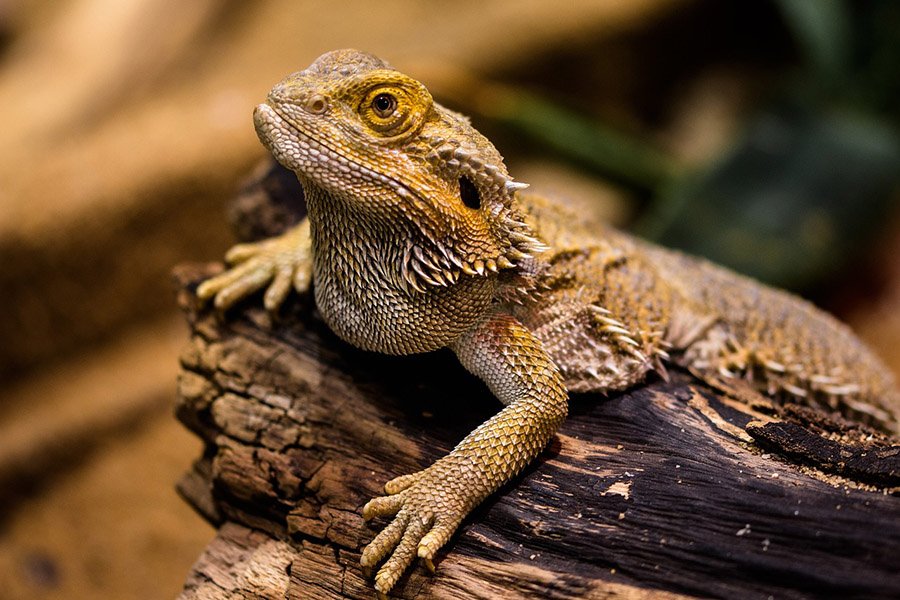
Description
Bearded dragons are named for the distinctive “beard” of spiky scales situated on the underside of their throat, which can puff up and darken when the lizard feels threatened or during mating displays.
Their bodies are robust, slightly flattened, and covered in spiky, rough scales, lending them a prehistoric appearance. They typically sport an earthy color palette, with hues of browns, oranges, and grays, although selective breeding in captivity has led to various color morphs.
A fully-grown bearded dragon can range from 18 to 24 inches (46-61 cm) in length, with males typically being larger than females. The tail comprises about half of their total length.
Sexual dimorphism is evident in bearded dragons. Males often have broader heads, darker beards, and a pair of enlarged scales (femoral pores) on the underside of their thighs. These pores exude a waxy substance used to mark territory. In contrast, females have slender bodies and smaller heads, and their femoral pores are less pronounced.
Bearded dragons also possess a set of specialized scales on the top of their heads known as the “parietal eye” or “third eye”. Though not an eye in the traditional sense, it can detect light and movement, aiding them in detecting overhead predators.
Habitat and Distribution
Originally from Australia, bearded dragons inhabit a wide range of environments, including deserts, savannahs, and arid woodlands. They prefer warm, dry areas and are adept climbers, often seen basking on branches, rocks, or fence posts during the day.
They have also adapted to some semi-urban areas, where they can be seen on fences or in gardens. The specific habitat may vary based on the species.
For instance, the Central bearded dragon resides in the arid regions of central Australia, while the Eastern bearded dragon inhabits the eastern states, from the southeastern coastlines to northeastern Queensland.
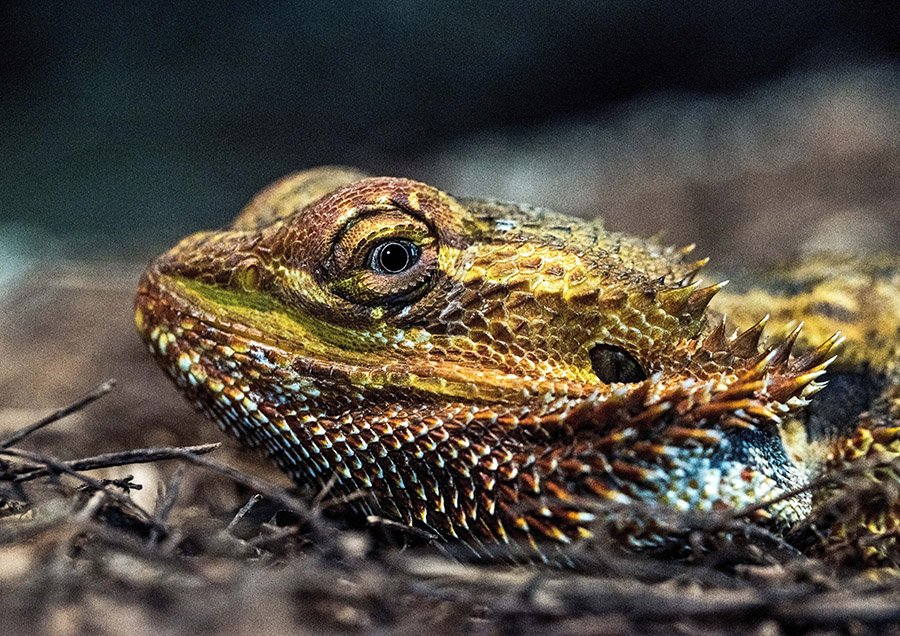
Behavior
- Diurnal Lifestyle: Bearded dragons are primarily diurnal, meaning they are active during the day. They spend their mornings sunbathing to elevate their body temperature and become more active as they warm up.
- Solitary Creatures: Bearded dragons are mostly solitary and can be territorial, especially males. In the wild, they maintain and defend their territories from other males, often engaging in displays of dominance that include inflating their beards, opening their mouths wide, and doing “push-ups”.
- Communication: They have rich body language. Waving a slow, raised arm is a common submissive gesture, often seen in younger dragons. Head bobbing, especially by males, is a sign of dominance or territoriality. They also communicate through color changes. For example, a black beard can indicate stress, aggression, or courtship behavior.
- Thermoregulation: Bearded dragons are ectotherms, relying on their environment to regulate their body temperature. They achieve this by basking in sunny spots during cooler parts of the day and seeking shade during the hottest periods. Their flattened bodies and spiky scales increase surface area, allowing for efficient heat absorption and dissipation.
- Brumation: In their natural habitat, bearded dragons might undergo a period of dormancy called brumation, similar to hibernation in mammals. During this time, they become less active, eat less, and may even burrow or hide for extended periods. This behavior is more pronounced in cooler climates and can last several weeks.
Diet and Feeding/Hunting Behavior
Bearded dragons have an omnivorous diet, consuming a mix of plant and animal matter. Their diet becomes more herbivorous as they age. Young bearded dragons eat a higher percentage of insects and other small animals, while adults consume more plants.
They feed on a variety of insects, including crickets, mealworms, and cockroaches. Their plant-based diet includes green leafy vegetables, fruits, and flowers. Occasionally, they might consume smaller lizards or rodents.
Bearded dragons are sit-and-wait predators. They remain still and patiently wait for prey to come within range before lunging quickly to snatch it with their sticky tongues. Their sharp, serrated teeth are ideal for holding onto prey. When feeding on plants, they are methodical, often consuming the most nutritious parts like flowers and tender shoots.
Predators
Bearded dragons, especially the young ones, face various predators in the wild. These include:
- Birds of Prey: Various raptors and large birds can snatch up bearded dragons from the ground or even in mid-air during their occasional jumps.
- Snakes: Several snake species, especially larger ones, see bearded dragons as a potential meal.
- Dingoes and Larger Lizards: In some parts of their range, dingoes or larger predatory lizards might prey on bearded dragons.
- Juvenile Vulnerability: Young bearded dragons are particularly at risk due to their small size. Apart from the predators mentioned, they can also fall victim to spiders, large insects, and other small carnivorous animals.
To avoid these threats, bearded dragons have developed various defensive tactics, such as inflating their bodies to appear larger, displaying their spiky and often dark-colored beards, and playing dead. They also have a camouflaged appearance that helps them blend into their surroundings.
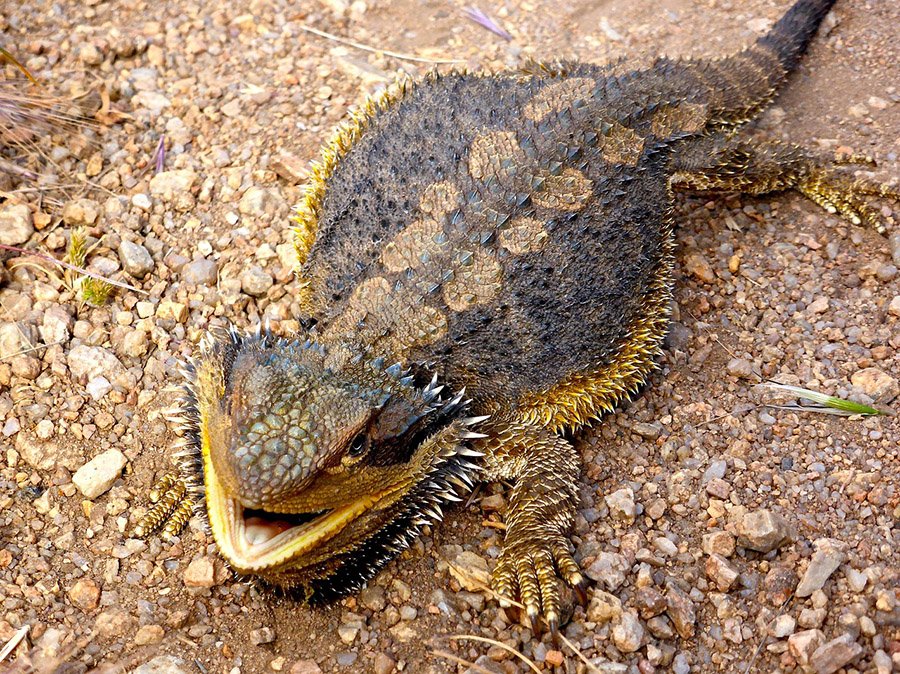
Reproduction and Life Cycle
The mating ritual of the bearded dragon involves the male displaying his beard, which turns black, as a sign of dominance. He will then approach the female, bob his head, and may circle around her. If the female is receptive, she will raise her tail, allowing the male to mate.
Bearded dragons are oviparous, meaning they lay eggs rather than giving birth to live young. After mating, a female will lay her clutch of eggs typically within 4 to 6 weeks.
A female bearded dragon can lay between 15 to 30 eggs in a clutch. She will dig a burrow in soft sand or dirt and deposit her eggs, then cover them. The eggs will incubate for around 55-75 days depending on the temperature. Once hatched, the young are independent and receive no further care from their mother. They mature rapidly, with some able to reproduce by the age of 8 to 12 months.
Conservation and Threats
The bearded dragon is listed as “Least Concern” on the IUCN Red List. They are not currently endangered, and their populations are stable in the wild.
While bearded dragons are not under significant threat, habitat loss due to urban development and agriculture can impact local populations. Additionally, they are popular in the pet trade, which can lead to over-collection from the wild in areas without proper regulations.
Various regions have introduced regulations to protect the bearded dragon from over-collection, ensuring that the pet trade is supplied by captive-bred individuals. Additionally, conservationists and local communities are working to maintain their natural habitats and educate the public about the importance of these charismatic reptiles.
Fun Facts
- Name Origin: The term “bearded dragon” refers to the “beard” of the lizard, the underside of the throat which can turn black and puff out as a defensive mechanism or during mating rituals.
- Waving Hi: Bearded dragons have a peculiar behavior where they slowly wave one of their arms. This behavior is believed to be a submissive signal, acknowledging larger dragons’ presence.
- Temperature Tint: Baby bearded dragons can change the shade of their color based on the temperature. When it’s cooler, they may darken to absorb more heat, and when it’s warmer, they can lighten up.
- Third Eye: Bearded dragons have a parietal eye, often referred to as the “third eye”, on top of their head. It doesn’t see images but can detect changes in light, helping them sense predators from above.
- Tails Tell Tales: Unlike some other lizards, bearded dragons cannot regenerate their tails. If they lose a part of it, it’s gone for good.
Frequently Asked Questions
What do bearded dragons eat in the wild?
In the wild, bearded dragons are omnivores. They consume a mix of insects, small animals, and plants, including fruits and flowers.
How can I tell the age of my bearded dragon?
It’s challenging to determine the exact age of a bearded dragon unless you’ve had it since birth. However, size can give a general idea: by 2 months they might be 6-9 inches long, and by 8 months they can reach up to 12 inches. Full-grown adults can be around 18-22 inches by 12-18 months.
Why is my bearded dragon’s beard turning black?
A bearded dragon might display a black beard for various reasons, including feeling threatened, trying to show dominance, during mating rituals, or when they’re not feeling well.
Can bearded dragons recognize their owners?
While they don’t recognize people in the same way mammals might, bearded dragons can become familiar with their owners. They can recognize scents, voices, and might even have a preferred person they’re more comfortable with.
How often should I feed my bearded dragon?
The feeding frequency depends on their age. Baby bearded dragons should eat 3-5 times a day, juveniles twice a day, and adults can be fed once a day or even once every other day, ensuring a mix of proteins and greens. Always consult a vet or specialist for specific dietary needs.
Other Articles To Learn More About Lizards
- What Do Lizards Eat? Everything You Wanted To Know
- Are Lizards Friendly? 12 Friendly Lizards Great As Pets
- What Eats Lizards? Learn All About Lizard Predators
- Are Lizards Dangerous? Do They Attack Humans?
- Agama Lizard: Characteristics, Diet, Facts & More [Fact Sheet]
- Basilisk Lizard: Characteristics, Diet, Facts & More [Fact Sheet]
